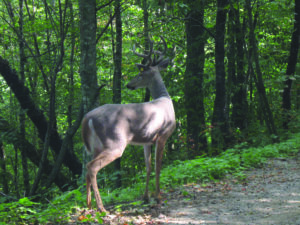An Archaeological and Ethnographic investigation of Whitetail Deer, Odocoileus virginianus, throughout the Traditional Cherokee Aboriginal Territory
By TYLER B. HOWE
Whitetail Deer, Odocoileus virginianus, was the main food source throughout the prehistoric southeastern United States. It was said that Whitetail Deer was “considered the ‘life staff’” of southeastern American Indians (Barkalow 1972 p. 31). As the most important food source, nearly every portion of the animal was utilized. Its flesh was used for clothing, drum heads, and other leather goods. The hooves were rendered into glue, or used as scrapers, while various bones were fashioned into projectile points, and so forth and so on. Prior to European contact, “white-tailed deer was the single most important mammal species in the Mississippian diet . . .” (Muller 1997 p. 229-231).

The photo above shows one of the 24 white-tailed deer bucks released by the EBCI Fisheries and Wildlife Program as part of a new white-tailed deer project. (Photo courtesy of Robert Blankenship)
In terms of the archaeological evidence for whitetail deer, deer skeletal and tool remains have been found throughout the Traditional Cherokee Aboriginal Territory. Archaic period remains, ca. 8000 BC, have been discovered around Guntersville Reservoir, along the Tennessee River, in northern Alabama. Speaking of Alabama, in a 1972 investigation of 23 sites along the Tennessee River Valley in Alabama, white-tailed deer remains were discovered in 92 % of the sites investigated. Roughly translated, white-tailed deer remains occurred in 22 of the 23 sites. They were “found in all cultural levels and constituted the bulk of skeletal material found in almost every collection” (Barkalow 1972 p. 31).
In North Carolina, whitetail deer remains were found at the Warren Wilson site, 31BN29, located in Buncombe County, within features dating to the Middle Woodland period, ca. 200 BC – 300 AD. Moreover, whitetail deer was noted as the most numerous mammalian remains at Coweeta Creek, 31MA34. It is evidenced by these discoveries that the 17th century Cherokee people living at Coweeta Creek, in modern Macon County, relied heavily on whitetail deer.
In other regions of the Traditional Cherokee Aboriginal Territory, such as Kentucky, and Tennessee, archaeological evidence illustrates that whitetail deer and wild turkey were the most important game during the Middle Archaic, while whitetail deer alone became the most prominent food source throughout the remainder of time prior to European contact. At the Eva site, in northern Tennessee, “around 90% of all the mammal bones . . . were from deer” (Hudson 1976 p. 47).
After contact with Europeans, American Indians throughout the southeastern United States became heavily involved in what has become known as the Deerskin Trade. It was not uncommon for Indian and European hunters to encounter herds numbering in the hundreds (Hudson 1976 p. 275). After the founding of Charlestown, modern Charleston, South Carolina, in 1670, southeastern American Indians became heavily involved in both the Deerskin Trade, and slave trade. Southeastern Indians at first became involved on the local level, but economic pressures increased the European desire for deerskins as well as the Indian’s indebtedness to the traders. Such pressures from 1699 to 1715 witnessed nearly 54,000 skins shipped annually. By the close of the Deerskin Trade in the 1740s and 1750s, the white-tailed deer was nearly extinct in the southeast. In 1707 alone 121,355 skins were shipped from Charlestown (Hudson 1976 p. 436).
From vital food source to drivers of economic trade between Cherokees and the European powers, white-tailed deer has played an integral role throughout the southeastern United States for nearly 10,000 years.
Resources:
Frederick S. Barkalow, Jr. “Vertebrate Remains from Archaeological Sites in the Tennessee Valley of Alabama” Southern Indian Studies 1972.
Charles Hudson 1976 The Southeastern Indians. The University of Tennessee Press, TN.
Jon Muller 1997 Mississippian Political Economy. Plenum Publishers, NY.
Howe is the tribal historic preservation specialist for the EBCI Tribal Historic Preservation Office.





